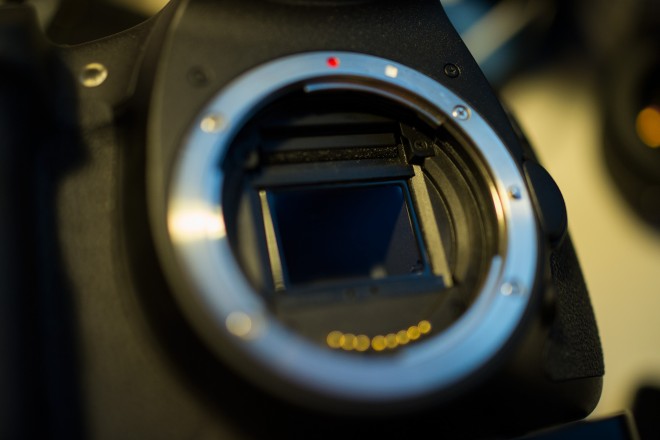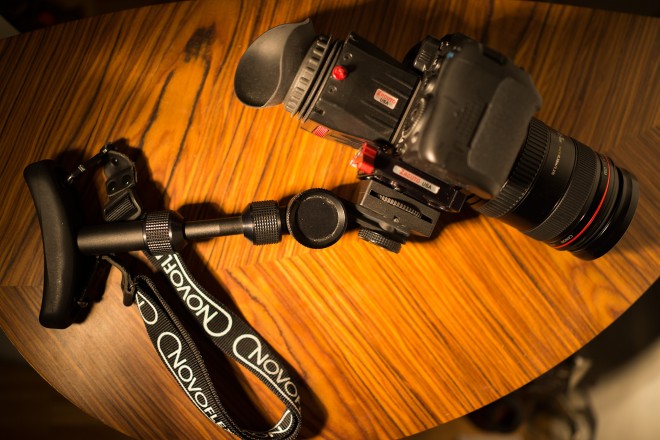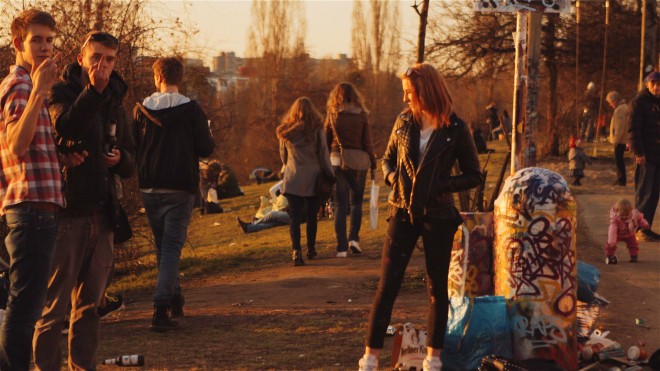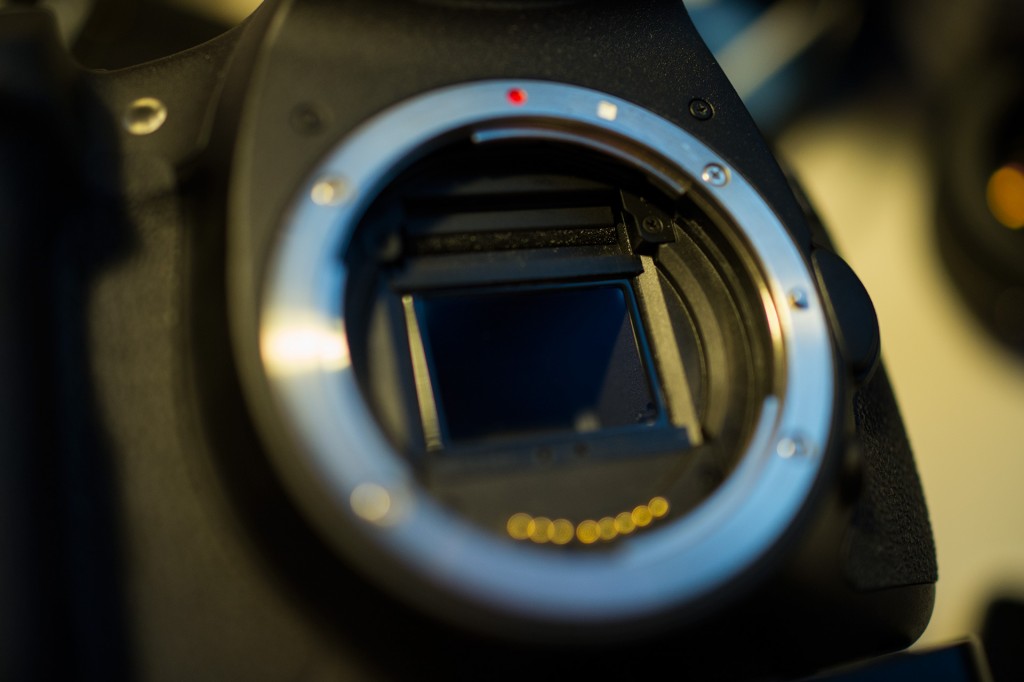In my opinion the Canon 7D is currently the best budget solution for shooting raw video. There’s plenty of used bodies going for $750 on eBay here – and that is practically a steal for 14bit raw video from a Super 35mm sized sensor… Stills camera is a mere bonus!
So to the big question – does the Mosaic Engineering VAF-7D filter completely cure the 7D’s raw video of moire and aliasing?
The answer is yes. I can’t perceive any moire or aliasing issues in my footage shot on the 7D with the filter installed.
It’s an incredibly impressive image. It just needed that filter, and of course the right workflow.
Previously
I last shot with the 7D and Magic Lantern when it was in a very early state. Some bugs still remain but it is much more fully functional this time. Here’s what I was able to do 6 months ago with it, all shot handheld with the Canon 35mm F2.0 IS.
[vimeo]http://vimeo.com/72605257[/vimeo]As you can see in places there’s some moire and aliasing, just like the original Canon video mode. Raw does not cure that.
The VAF-7D does and overall you get a much smoother image as a result, which you can add varying amounts of sharpness in post on top of just like with the 5D Mark III.
The VAF-7D filter is $295 from Mosaic here
Raw ability
Magic Lantern have done a terrific job of giving us more features on Canon DSLRs which the conservative bosses in Tokyo didn’t think anyone would need.
Fact is we do.
When it comes to raw video there’s no better format for grading, but essentially for these cameras it offers a way out from Crapshot™ image quality in video mode that hasn’t budged an inch since nearly 5 years ago.
Raw video for me is not about extracting the last drop of the 12 stops dynamic range on the sensor, though you can get a surprising amount back from the highlights with it enabled (move over Technicolor CineStyle)… It’s about colour.
There’s no WAY I could have achieved the kind of golden brown sun drenched look of this video without it, and I didn’t even grade from the master raw files. I swiftly converted everything to ProRes 422 HQ and set Film Convert to work in Premiere. This is really easy to do. It is much quicker and requires only the barest smattering of DaVinci Resolve knowledge.
At first I converted the DNG files to ProRes LT which has a lower bitrate of 100Mbit/s for double the space saving over ProRes 422 HQ, but Film Convert seemed less blocky in the shadows with the HQ variant, especially since I was applying such a heavy grade to the image and bringing the exposure to the right.
The ProRes 422 HQ is so good I feel reasonably confident in deleting the massive original raw files and freeing up drive space long term. Once you have perfected the workflow, you realise you don’t actually need to grade the raw files at all. Just set everything to BMCC Film gamma in Resolve and select that profile in Film Convert when you come to edit the ProRes in Premiere. Yes Film Convert has profiles for the original 7D H.264 video mode but the image quality is so far removed from that murky crap with raw, it is much closer to the BMCC and Pocket Cinema Camera. The benefit of BMCC Film gamma in Resolve is it gives you flat ProRes which reacts well to heavier grading and colour correction in Film Convert and Premiere. It’s pretty much LOG like from a high end Sony cinema camera.
The 7D in terms of overall image quality is not quite up there with the 5D Mark III for raw, which is truly spectacular, but it is comparable to the Blackmagic Pocket Cinema Camera and more feature-packed. In fact the 7D has gone from not having any Magic Lantern at all, to being almost fully functional in a very short space of time. The 7D uses a different internal processing architecture with parallel processing and two DIGIC chips. Tricky to program for but they did it.

The shoot
My Berlin friend Volker has taken to leaving his tripod at home and using a monopod with his 5D Mark II for raw video, an approach which seems to be working really well. The secret is to use a loupe over your LCD as an EVF and contact point with your body. This stops the monopod swaying too much. The monopod is much better at supporting the weight of the camera than your arm so it’s less fatiguing to shoot with one compared to no rig at all, but much smaller and lighter to carry around everywhere than a full rig or video tripod.
For the first half of this shoot I shot this way, then at the Berlin Mauerpark for day two I had a lucky find. This Novoflex stock was part of a super-tele 600mm lens from the same company. I didn’t want to buy that but the seller very graciously (or foolishly?) allowed me to buy it separately for 60 euros! This with the Zacuto Z-Finder on the back of the 7D is actually even more stable than the monopod approach and it is this I used for the second day of the test.

The filter
The 5D Mark II also shoots very good raw video with the Mosaic Engineering VAF-5D2 filter installed and thanks to the guys at Mosaic Engineering / Optoelectronics I now have their 7D version. The design has changed a bit since the early days. It is not a thin window frame with the glass, that sits on top of the mirror box just behind the lens mount. It is not a box construction that rests on mounting points closer to the sensor. It is really thin and comes with a special too for putting it in and taking it out. Of course it still stops the optical viewfinder mirror from coming down to supply an image to the viewfinder but that happens in video mode on DSLRs anyway so you are not losing any functionality.
I found the filter does soften the image quite dramatically but this is exactly what’s needed for smooth video. With a bit of sharpening in post the results are really nice.
The only problem I find is that the image is extremely soft in the magnified focus assist, making manual focus harder to confirm that way. The 7D’s screen resolution is a little on the pixilated side as well with the high magnification of the Zacuto Z-Finder. So I recommend stopping down the lens for some margin or using an external EVF instead. I was using the Canon 24-70mm F2.8L for this shoot and had no problems with vignetting at the wide end with the filter installed, or indeed much in the way of soft corners. When I last tested the VAF for the 5D Mark II it didn’t play too well with wide angle on the full frame sensor due to soft corners at 24mm. On the 7D it seems at least at the moderately wide 24mm end of my lens it worked fine. I have seen the same 24-70mm F2.8L work well with the latest version of the VAF-5D2 on full frame but haven’t tested it myself yet.
I find bokeh has a different, more antique look to it with the filter installed – it’s slightly more fussy but the look is quite arty. Sometimes that might not be what you want. I recommend seeing it for yourself and deciding whether you like the slightly lower contrast fuzzy bokeh or not. The other side affect is your focus marks on the lens don’t match the actuality and your minimum focus distance changes – but really most of the time you’ll not notice this unless you are measuring out precise marks for actors and focus pullers!
Moire and aliasing becomes practically a non-issue with the filter installed and that’s exactly the objective of the filter. So mission accomplished. In addition to the main video above I have put some of the cutting room floor material in a shorter video below, which attempts to invoke moire and aliasing with lots of brickwork. This video also shows ungraded footage vs Film Convert graded footage and just how extremely I have graded the LOG ProRes 422 HQ… Impressive how it holds up.
[vimeo]http://vimeo.com/88837958[/vimeo]Raw for me in this case was simply a vessel to get the image quality I know the 7D is capable of out of the camera and into ProRes format. None of that rubbish internal Canon processing with the under-specced (for video) DIGIC chip.
The Cinema DNG workflow was a lot better for me than in the early days of Magic Lantern raw shooting because Resolve 10 now supports standard DNG. You don’t need an app like Raw Magic to develop Cinema DNG from the raw files. Magic Lantern’s own raw2dng app is free and the DNG frames it produces can now be used in Resolve as raw video sequences.
From 96GB of raw video the ProRes 422 HQ weighed in at 28GB, a good space saving. ProRes LT would be half that size at around 14GB – fine if not doing such heavy grading or Film Convert processing.
The transcode from raw to ProRes in Resolve 10 went faster than realtime – around 37fps – on my iMac 27″ thanks to CUDA on the Nvidia GTX 775M 2GB, you don’t need a high spec PC or a Mac Pro.
This CUDA acceleration of rendering DNG raw is something Adobe desperately needs to add support for in After Effects and Premiere. After Effects is so slow at transcoding DNG to ProRes it crawls along at 2fps.
In Film Convert I used the lovely warm Fuji Prov 100 film stock.
Rant
Something I have observed having been in Berlin for 3 years now. A great many Berliners appear to dislike cameras.
Aside from the UK where I am from, I have also lived in Asia and in both the UK and Asia I felt comfortable taking photos or videos. The Taiwanese and Japanese in particular – ultra polite and friendly towards foreigners pointing DSLRs in their general direction. My shooting strategy in Asia was to use a small DSLR to ‘blend in to the background like a tourist’. With a huge shoulder mounted camera you might intimidate people and get unnatural reactions. The DSLR has a ‘stealth factor’.
That worked great for me until I came to Berlin where it works the other way round! The DSLR today is associated with tourism, whether we like it or not and it is not actually the camera Berlin hates but the tourists. The more I rig up my camera the more respectful people are and the more they like to stop and chat. The smaller the camera and the more like a tourist I look, the more vitriol and dirty looks I get from people… who half the time don’t realise I am their own neighbour!
I am thinking of painting in big letters on my jacket “NOT A TOURIST” so they go easier on me. What seems like an act of embarrassing teenage rebellion in the shot below is actually pretty normal behaviour for Berliners who are utterly sick of tourists ‘taking over their beloved city’. I say grow up, frankly. Tourism is not responsible for your rent rises. The business community is and so is the government, the basic laws of supply and demand and capitalism.

Both times I was at the long end of a zoom and a very respectful distance from the subject, taking in the general atmosphere of my own neighbourhood in a public place there to share. Isn’t it sad that whenever a machine comes between people, for example road rage, forum trolling or a DSLR between me and the guys here, there’s no restraint in rudeness people feel they can get away with. This has lead me to quite an interesting conclusion… that machines are really bad for us. People just don’t realise how impersonal we are getting with each other behind our Facebook accounts and iPhones. The internet has replaced a lot of day to day contact and trivialised a lot of communication we once did face to face or one voice to another and out of the window has gone the ‘social contract’. My advice to the people in the shot above is next time you pigeonhole someone as a ‘bloody tourist with a DSLR’ wait for him to put the camera down and go and chat face to face to see who he actually is.
***



